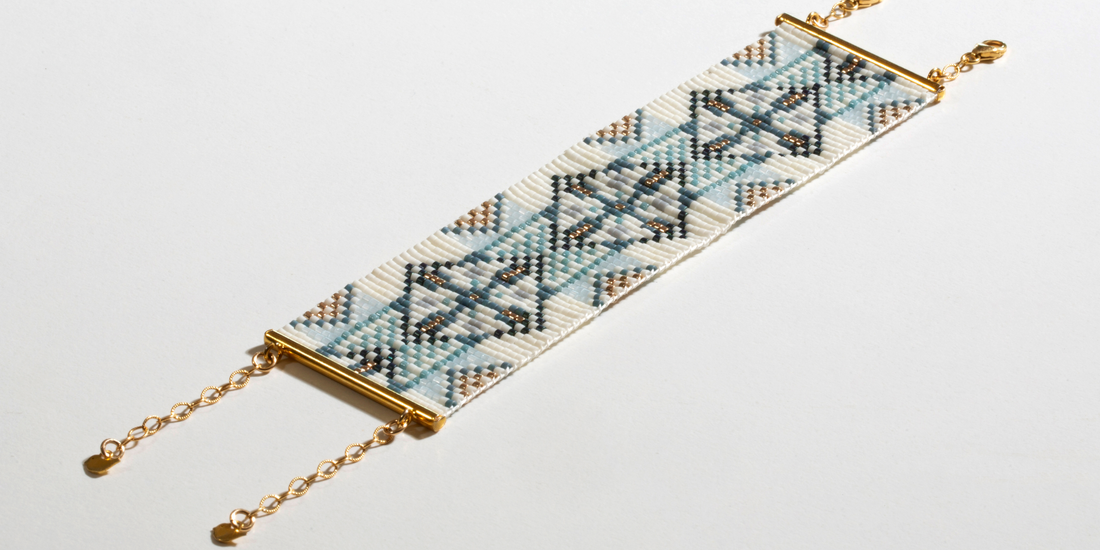Introduction
Tatreez, the traditional Palestinian embroidery, is more than just a craft; it is a form of cultural expression that carries deep historical and social significance. This article delves into the rich heritage of Tatreez, its cultural importance, and how it has been beautifully represented in jewellery design, transforming traditional patterns into exquisite pieces of wearable art.
Historical Background
Tatreez has been a significant part of Palestinian culture for centuries. It began as decorative stitching on garments, particularly women's dresses known as "thobes." The intricate designs and patterns of Tatreez reflect the rich history and heritage of the Palestinian people, with each stitch telling a story of the community, family, or individual.
Cultural Importance
Tatreez is a vital means of preserving and conveying cultural identity. Historically, Palestinian women used this embroidery to express their social and marital status and regional identity. Beyond aesthetics, Tatreez serves as a way to pass down stories, traditions, and skills from one generation to the next, ensuring the continuity of cultural heritage.
Traditional Techniques of Tatreez
Embroidery Methods
Tatreez involves various stitching techniques, including cross-stitch, satin stitch, and running stitch. These methods require precision and skill, with each piece taking considerable time and effort to complete. Traditionally, the embroidery is done on natural fabrics like linen or cotton, using brightly colored silk or cotton threads.
Common Motifs and Patterns
Tatreez features a wide range of motifs, each with its own significance. Common designs include geometric shapes, floral patterns, and representations of animals and everyday objects. The patterns are often symmetrical and repetitive, creating a harmonious and visually appealing design.
Symbolism in Tatreez
Meanings of Motifs
The motifs in Tatreez carry deep symbolic meanings. For example, the cypress tree symbolizes resilience and eternal life, while the comb represents femininity and beauty. These symbols add layers of meaning to the embroidery, making each piece a rich tapestry of cultural narratives.
Regional Variations
Tatreez varies significantly across different regions of Palestine, with each area having its own distinctive patterns and color schemes. For instance, the embroidery from Hebron is known for its dense and intricate designs, while the patterns from Ramallah are lighter and more delicate. These regional variations highlight the diversity and richness of Palestinian cultural heritage.
Tatreez in Modern Times
Revival and Preservation
In recent years, there has been a revival of interest in Tatreez, driven by efforts to preserve and celebrate Palestinian cultural heritage. Organizations and artisans are working to keep the tradition alive by teaching embroidery skills, creating contemporary designs, and promoting Tatreez in global markets.
Contemporary Uses
Tatreez has found new life in contemporary fashion and design. It now embellishes various items, from clothing and accessories to home decor. This modern adaptation allows Tatreez to remain relevant and appreciated by new generations.
Transformation of Tatreez into Jewellery
Design Process
Transforming Tatreez into jewellery involves a meticulous design process. Designers draw inspiration from traditional embroidery patterns and reinterpret them into wearable art. This process includes sketching designs, selecting materials, and crafting the pieces with great attention to detail.
Techniques and Materials
Creating Tatreez jewellery requires blending traditional embroidery techniques with modern jewellery-making methods. Artisans may use recycled sterling silver and recycled gold-filled metals to create the base of the jewellery, onto which they apply embroidered fabrics or replicate embroidery patterns using techniques like engraving and enameling.
Examples of Tatreez Jewellery
Iconic Collections
Several collections of Tatreez jewellery have gained recognition for their beauty and cultural significance. These collections often feature earrings, necklaces, bracelets, and rings that showcase traditional Palestinian embroidery patterns.
Notable Designers
Notable designers like Rana Salam and Hania Zawahra have made significant contributions to Tatreez jewellery. Their innovative designs blend traditional motifs with contemporary aesthetics, creating pieces that are both culturally rich and fashion-forward.
Cultural Impact of Tatreez Jewellery
Connection to Heritage
Tatreez jewellery serves as a powerful connection to Palestinian heritage. By wearing these pieces, individuals can express their cultural identity and pride. The jewellery acts as a tangible link to the past, preserving the stories and traditions of Palestinian culture.
Global Recognition
The global recognition of Tatreez jewellery has helped raise awareness about Palestinian culture and craftsmanship. These pieces are celebrated not only for their beauty but also for the cultural stories they represent, fostering a greater appreciation for Palestinian heritage worldwide.
Challenges in Preserving Tatreez
Political and Social Issues
The preservation of Tatreez faces several challenges, including political and social issues. The ongoing conflict in the region has disrupted traditional ways of life and limited access to resources and markets for artisans. Despite these challenges, efforts to preserve Tatreez continue through the dedication of communities and organizations.
Efforts for Sustainability
Sustainable practices are crucial for the continued preservation of Tatreez. This includes using eco-friendly materials, supporting fair trade practices, and creating economic opportunities for artisans. These efforts help to ensure that Tatreez remains a viable and vibrant part of Palestinian culture.
Future of Tatreez in Jewellery Design
Emerging Trends
Emerging trends in Tatreez jewellery design include using innovative materials and techniques, as well as collaborations with international designers. These trends are helping to bring Tatreez to a broader audience and ensuring its place in contemporary fashion.
Innovations and Technology
Innovations and technology are playing a significant role in the evolution of Tatreez jewellery. Digital design tools, 3D printing, and modern production methods allow for greater creativity and precision, enabling designers to push the boundaries of traditional Tatreez.
Conclusion
The cultural significance of Tatreez and its representation in jewellery highlight the enduring beauty and richness of Palestinian heritage. By transforming traditional embroidery into exquisite pieces of jewellery, artisans and designers are preserving and celebrating this unique art form. Tatreez jewellery not only honors the past but also paves the way for a vibrant future, ensuring that this cultural treasure continues to inspire and captivate for generations to come.

